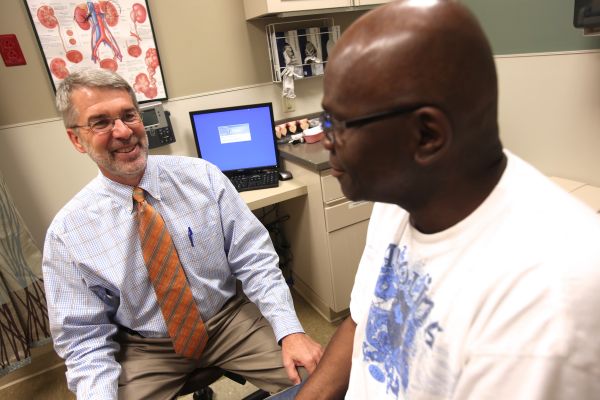“I’m African-American, and my father had it, too.”
“Nothing! I had a PSA test and my level was very high.”
“I had trouble urinating, and very little would come out.”
Recognizing the signs and symptoms of cancer can sometimes be difficult — especially when it comes to prostate cancer. Symptoms may be vague or may not appear at all until the cancer is in the later stages.
Be sure to tell your doctor if you experience any of these symptoms:
- Difficulty starting to urinate
- Decreased urine flow
- Blood in the urine
- Bone pain
- Discomfort in the pelvic area
- Swelling in your legs
In most cases, these symptoms are due to conditions that are benign (not cancer), such as an infection or enlarged prostate. But if you're worried about prostate cancer, you should talk to your doctor about both the risks and benefits of having a PSA test, which is used for early detection. Developed here at Roswell Park in the 1970s, the PSA test was originally designed to monitor the progression of prostate cancer in men who had already been diagnosed with the disease. Since then, it has become a useful tool — along with a digital rectal exam (DRE) — for early detection of the disease.
What Is the PSA Test?
The PSA test is a simple blood test that measures the level of a protein called prostate-specific antigen (PSA) in a blood sample. Higher-than-normal PSA levels may indicate the presence of cancer. However, other conditions that are not cancer — such as an enlarged prostate, urinary tract infection or constipation — can elevate PSA, too. Higher PSA may also be caused by vigorous exercise, riding a bicycle, drinking alcohol and ejaculating, so you’re advised not to do any of those things for at least three days before a PSA test.
In general, the higher your PSA level, the more likely prostate cancer is present, especially if your PSA rises over time.
Do I Need Early Detection Testing?
You should talk with your primary care physician about when you should start early detection screening. Early detection testing is recommended only for men who might be at greater risk of dying of prostate cancer, including:
- African-American men
- Men with a father or brother who had prostate cancer — especially if they were younger than 60 at the time of diagnosis
- Men who have undergone genetic screening and have been told that they have a genetic mutation (such as BRCA1, BRCA2, ATM, HOXB13, MLH1, MSH2 or MSH6)
If you fall into one of the categories above, you should talk with your doctor about beginning early detection testing at age 40. Results of the first test are called the baseline. After that, the results of regular follow-up tests will be compared with the original results to see whether your PSA levels are going up or down.
If you have a family history of prostate cancer, you should talk with your doctor about beginning early detection testing 10 years before the age of the earliest prostate cancer case in your family. For example, if your father or brother received a prostate cancer diagnosis at age 45, you might want to begin testing at age 35.
If you do not fall into any of the groups above, you may want to ask your doctor about beginning early detection with a baseline PSA test and digital rectal exam at age 45. The baseline results will be compared with the results of future tests, and that information will help determine how often you should have follow-up testing.
If you are over the age of 70, the PSA test is not recommended unless you are very healthy and have a life expectancy of 10 years or more.
Not All Prostate Cancers Need to be Treated
Prostate cancer is the most common cancer in men. But it’s important to remember that most men who get it will not die of it. Many men with prostate cancer can safely choose active surveillance instead of starting treatment immediately. However, some prostate cancers are aggressive and need to be treated before the disease spreads. Early detection testing finds both slow-growing and aggressive cancers, so it’s important to use a number of tests — PSA, digital rectal exam, MRI scans and biopsy — to determine the type of prostate cancer you have.
Life has opened back up. Now it’s time to get back to health.
If you’ve waited to schedule your cancer screening, delayed your doctor’s appointments or are ignoring that lingering symptom that is just not right – now is the time to act.


